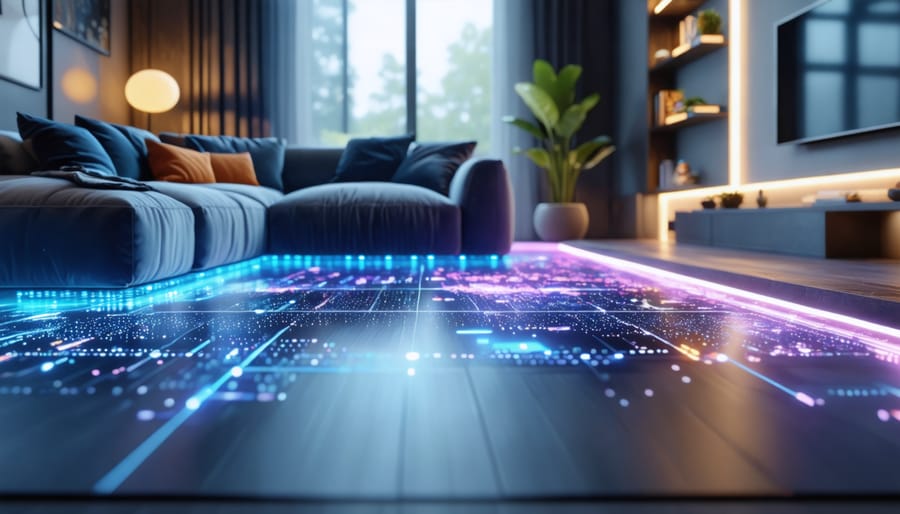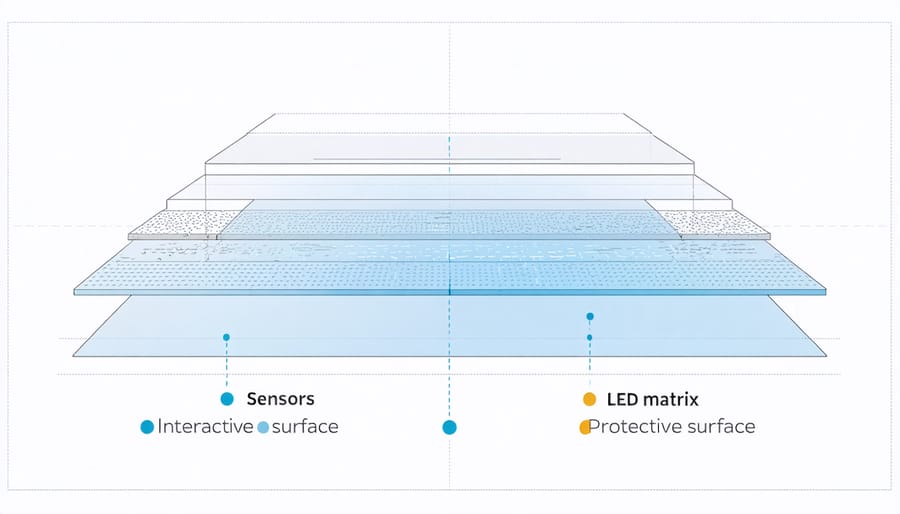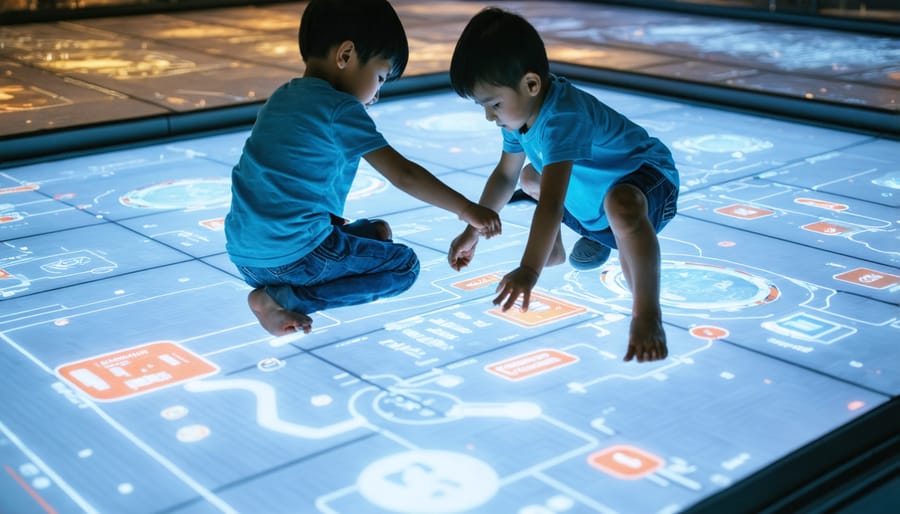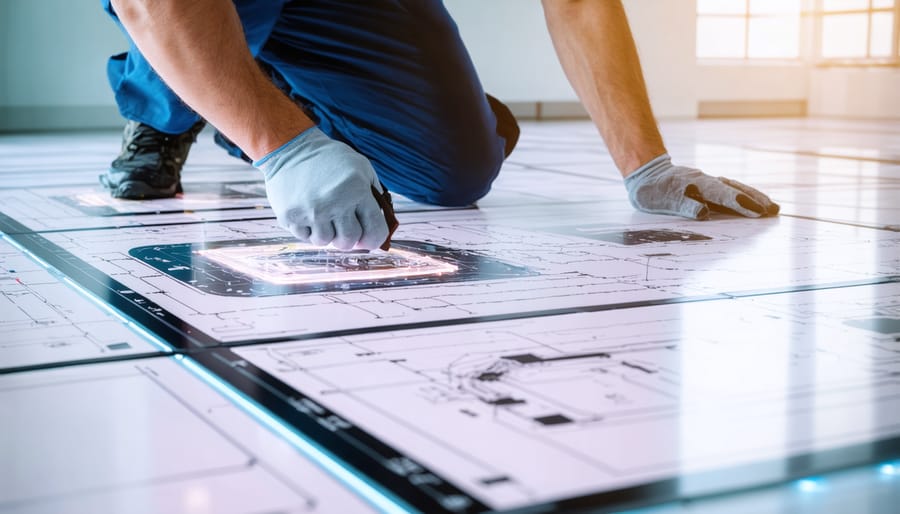
Smart Floors That React to Your Steps: The Future of Interactive Flooring Is Here
Step into the future of flooring technology, where every footstep can trigger lights, sounds, or interactive displays beneath your feet. Interactive flooring transforms ordinary surfaces into dynamic, responsive environments that blend seamlessly with modern smart home design features. This revolutionary technology combines pressure-sensitive sensors, LED displays, and sophisticated software to create immersive experiences that respond to movement and touch.
Whether enhancing retail spaces with engaging customer experiences, creating interactive learning environments in schools, or adding an element of wonder to residential spaces, interactive flooring represents the intersection of technology and interior design. The systems can be customized to display anything from simple light patterns to complex interactive games, making them versatile solutions for both commercial and residential applications.
Beyond mere novelty, these intelligent surfaces offer practical benefits like improved engagement in educational settings, enhanced safety through programmable emergency exit paths, and innovative ways to capture foot traffic data in retail environments.
What Makes a Floor Interactive?
Sensor Technology
At the heart of interactive flooring lies a sophisticated network of sensors and lighting elements working in perfect harmony. Pressure-sensitive sensors embedded throughout the floor surface detect footsteps and movement patterns, instantly responding to any weight or pressure changes. These sensors are typically arranged in a grid pattern, creating countless interactive zones across the floor’s surface.
Motion detectors complement the pressure sensors, tracking movement patterns and enabling more complex interactions. This dual-sensor approach ensures accurate response timing and helps eliminate false triggers. The integration of LED technology brings these interactions to life through smart lighting integration, creating dynamic visual displays that respond to movement.
The sensor system’s control unit processes all this information in real-time, translating physical interactions into predetermined light patterns, colors, or effects. Modern interactive flooring systems can handle multiple simultaneous interactions, making them perfect for high-traffic areas. The durability of these sensors is impressive, with many systems rated for years of continuous use under normal conditions.

Software Systems
Interactive flooring systems are powered by sophisticated yet user-friendly software that brings the floor to life. Most systems come with intuitive control panels or smartphone apps that let you customize and manage your interactive floor experience. These controls allow you to switch between different effects, adjust sensitivity levels, and even create custom patterns or games.
The programming capabilities range from simple preset animations to complex interactive scenarios. You can schedule different effects for specific times of day, sync the floor with music for dance applications, or create triggered responses to movement. Many systems also include content management platforms where you can upload your own designs or choose from existing libraries of effects.
For business owners, these systems often include analytics tools that track foot traffic patterns and engagement levels. The software can be updated remotely, ensuring your interactive floor stays current with the latest features and security patches. Most manufacturers provide regular software updates and technical support to keep your system running smoothly.
While some basic systems operate with simple plug-and-play functionality, others offer advanced programming options for those who want to create unique, customized experiences.
Practical Applications in Modern Spaces
Home Entertainment
Transform your home entertainment space into an immersive playground with interactive flooring technology. Gaming rooms become truly engaging when equipped with pressure-sensitive floors that respond to movement and touch. Imagine playing virtual soccer in your basement, where the floor displays the field and tracks player positions, or enjoying dance games where the floor lights up with each step.
These systems are particularly popular in family rooms, where children can engage in educational games projected onto the floor while learning numbers, letters, or problem-solving skills. Adults aren’t left out either – interactive floors can enhance movie nights by creating ambient lighting effects that sync with your film, or turn your living room into a virtual zen garden for relaxation.
For the ultimate gaming setup, combine interactive flooring with surround sound and smart lighting systems. Many modern interactive floor systems come with pre-loaded game libraries and the ability to download new content. Some even allow you to create custom interactive experiences, perfect for parties or unique family entertainment needs.
When planning your interactive entertainment space, consider the room’s dimensions and ceiling height to ensure optimal projection quality and sensor functionality.
Commercial Applications
Interactive flooring has revolutionized commercial spaces, transforming ordinary floors into engaging, dynamic surfaces that enhance customer experiences. Retail stores have embraced this technology to create immersive shopping environments, with interactive displays that respond to footsteps, showcase products, and guide customers through the space. These installations have become integral modern interior design elements that combine functionality with entertainment.
Museums have particularly benefited from interactive flooring, using it to bring exhibits to life and create educational experiences that visitors won’t forget. From historical timelines that illuminate beneath visitors’ feet to interactive game-based learning experiences, these installations make learning more engaging and accessible for all ages.
Public spaces such as airports, hotel lobbies, and entertainment venues have also adopted interactive flooring to enhance visitor experiences. These installations can display wayfinding information, create ambient effects, or provide entertainment for waiting passengers. Shopping malls use the technology to create attention-grabbing advertisements and interactive games that encourage longer visits and increased engagement.
Corporate offices are incorporating interactive floors in reception areas and collaborative spaces to make lasting impressions on clients and create more dynamic work environments. The technology can display company branding, share real-time information, or facilitate team-building activities.
The versatility of interactive flooring in commercial settings extends to practical applications like crowd flow management and social distancing guidance, proving that this technology can be both entertaining and functional. As the technology continues to evolve, we’re seeing more creative applications that blend seamlessly with business objectives while delivering memorable experiences to users.

Installation and Maintenance

Professional Installation Requirements
Installing interactive flooring requires careful planning and professional expertise to ensure optimal performance. While DIY installation might be tempting, professional installation is strongly recommended due to the complex integration of electronic components and specialized materials.
The installation process typically begins with a thorough assessment of the subfloor, which must be completely level and free from moisture issues. Proper electrical infrastructure is crucial, including dedicated power circuits and network connectivity points. Most systems require careful placement of sensors, projectors, or LED panels, depending on the type of interactive flooring chosen.
Temperature and humidity control systems may need to be installed or modified to protect the electronic components. Additionally, proper ventilation is essential to prevent overheating of the system’s hardware. The installation team will need to carefully map out traffic patterns and user interaction zones to optimize sensor placement and responsiveness.
Professional installers will also ensure proper calibration of all components, including motion sensors, pressure sensors, and display systems. They’ll conduct thorough testing of all interactive features and make necessary adjustments before finalizing the installation.
Post-installation, professionals will provide essential training on system operation and maintenance procedures. Most reputable installers offer warranty coverage and ongoing technical support, which is particularly valuable for commercial installations where system downtime could impact business operations.
Care and Upkeep
Regular maintenance is crucial for keeping your interactive flooring system performing at its best. Clean the surface daily with a soft microfiber mop and mild cleaning solution specifically recommended for your system type. Avoid harsh chemicals or abrasive cleaners that could damage the sensitive sensors or display components.
For commercial installations, schedule professional maintenance checks every six months to ensure all sensors, projectors, and electrical components are functioning correctly. In residential settings, annual check-ups are typically sufficient. Keep the sensor areas free from dust and debris, as these can interfere with proper functionality.
To extend your system’s lifespan, maintain consistent room temperature and humidity levels, as extreme conditions can affect electronic components. Consider installing protective overlays in high-traffic areas to prevent wear. Most interactive flooring systems last 5-7 years with proper care, though some premium systems can last up to 10 years.
Back up your system’s custom settings and content regularly, and keep a log of maintenance activities. If you notice any performance issues, address them promptly to prevent more serious problems from developing.
Cost Considerations and ROI
Interactive flooring represents a significant investment that varies widely based on system complexity and installation requirements. For residential applications, basic interactive floor systems typically start around $3,000 for a small area (100 square feet), while commercial-grade systems can range from $10,000 to $50,000 or more for larger spaces.
Installation costs generally account for 20-30% of the total investment, including necessary electrical work and surface preparation. However, the long-term value often justifies the initial expense, particularly for businesses. Entertainment venues, retail stores, and educational facilities frequently report increased foot traffic and engagement rates of 40-60% after installing interactive floors.
Maintenance costs are relatively low, mainly involving regular cleaning and occasional software updates. Most systems have a lifespan of 5-7 years, though the projection equipment may need replacement after 3-4 years of heavy use. Energy consumption is comparable to standard digital signage, typically adding $30-50 to monthly utility bills.
The ROI timeline varies by application. Retail environments often see returns within 12-18 months through increased sales and customer engagement. Educational facilities benefit from enhanced learning experiences, while residential installations can boost property value by 1-2% in luxury markets.
To maximize ROI, consider starting with a smaller installation area and scaling up based on performance. Many manufacturers offer financing options and modular systems that allow for gradual expansion as needs and budget permit.
Interactive flooring represents a revolutionary step forward in how we interact with our living and commercial spaces. By combining cutting-edge technology with practical design, these systems offer unprecedented opportunities for customization, engagement, and functionality. From enhancing retail experiences to creating immersive learning environments, interactive floors have proven their worth across various applications. As technology continues to advance, we can expect to see even more innovative uses, improved durability, and greater accessibility in terms of cost and installation. Whether for business owners looking to create memorable customer experiences or homeowners seeking unique entertainment solutions, interactive flooring offers a future-forward approach to space design that combines practicality with endless creative possibilities. The growing adoption of this technology suggests it will become an increasingly common feature in both commercial and residential spaces in the years to come.
